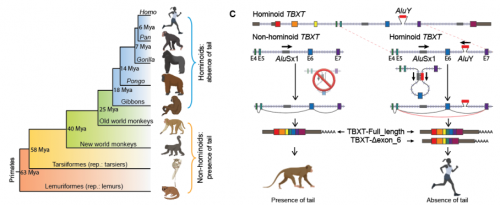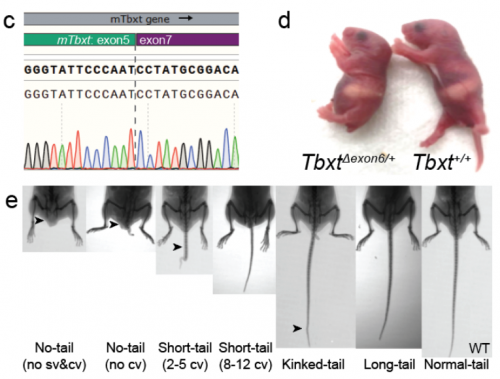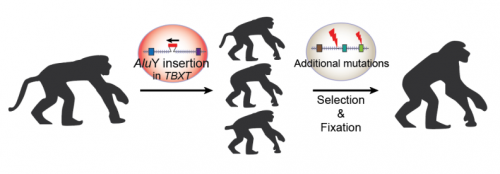But mostly accurate.
In the Index to Creationist Claims, rebutting the claim by Henry Morris that No new species have been observed
, it is written:
New species have arisen in historical times. For example:
A new species of mosquito, isolated in London’s Underground, has speciated from Culex pipiens (Byrne and Nichols 1999; Nuttall 1998).
This claim that a new species arose since the London Underground was built has been widely reported.
In 1999, an English researcher named Katharyne Byrne went underground to investigate further. When she compared Underground mosquitoes and compared them to others found in London houses, she learned that they were a distinct subspecies.
After ruling out migration from elsewhere in the continent, Byrne concluded that the London Underground was colonized by mosquitoes a single time, then achieved “reproductive isolation,” or barriers to reproduction with different species, in the subway tunnels.
“In the continent” is the critical phrase here. As it turns out, they didn’t look far enough afield — they needed to look at species in North Africa. The London Underground mosquito has a deeper history than the London Underground!
The northern house mosquito Culex pipiens sensu stricto is one of the most important disease vector mosquitoes in temperate zones across the northern hemisphere, responsible for the emergence of West Nile Virus over the last two decades. It comprises two ecologically distinct forms — an aboveground form, pipiens, diapauses in winter and primarily bites birds, while a belowground form, molestus, thrives year-round in subways, basements and other human-made, belowground habitats, bites mammals, and can even lay eggs without a blood meal. The two forms hybridize in some but not all places, leading to a complex ecological mosaic that complicates predictions of vectorial capacity. Moreover, the origin of the belowground molestus is contentious, with iconic populations from the London Underground subway system being held up by evolutionary biologists as a preeminent example of rapid, in situ, urban adaptation and speciation. We review the recent and historical literature on the origin and ecology of this important mosquito and its enigmatic forms. A synthesis of genetic and ecological studies spanning 100+ years clarifies a striking latitudinal gradient — behaviorally divergent and reproductively isolated forms in northern Europe gradually break down into what appear to be well-mixed, intermediate populations in North Africa. Moreover, a continuous narrative thread dating back to the original description of form molestus in Egypt in 1775 refutes the popular idea that belowground mosquitoes in London evolved in situ from their aboveground counterparts. These enigmatic mosquitoes are more likely derived from populations in the Middle East, where human-biting and other adaptations to human environments may have evolved on the timescale of millennia rather than centuries. We outline several areas for future work and discuss the implications of these patterns for public health and for our understanding of urban adaptation in the Anthropocene.
It’s still evolution, just evolution over millennia rather than less than a century.
Strangely, I have reached a similar but far less flattering conclusion from watching creationists.
It’ll be a casual science convo on Friday at 3pm Central. I’m not going to do a lot of prep work because I don’t have the time, but I can talk about new evolutionary features off the top of my head. How about mammary glands? You like mammary glands?
If you’re one of my patrons (only a dollar a month, cheap), you can also join in the Zoom call. If you hate long-winded livestreams, I’ll also pluck out one of the more interesting excerpts and post that on Saturday.
If you’re bored and feel like exploring all of life, try the One Zoom explorer. It’s a graphical interface to a collection of data about phylogeny.

It’s interesting and useful at the top level, but as you dig down into the twigs and leaves, it starts to fall apart, lacking in detail. That’s what you’d expect if you’re trying to track about 1.5 million documented species (somewhere over 10 million species total). It does help communicate the diversity and complexity of life, though.
OK, so atheists shouldn’t take credit for a decline in religion, but I think science communicators and educators (which is not synonymous with atheism, I’m sure you know) have accomplished something: the gradual decline of creationism. More people are accepting evolution!

In the early years of this blog, way back in the 2000s, I felt a bit of frustration and despair because when I looked at the surveys, all I saw then was a flat line: less than half the population accepted a well-supported scientific fact, and 40% openly rejected it in favor of nonsense contradicted by all the evidence. And the statistics were flat-lined back into the 1960s, when the surveys began! It was all very discouraging, but also motivated a lot of us to get out there and do public science communication. It seems to have worked.
At least, I think educating the public helped. Another factor is that evolution has also become a tribal marker. If you’re a True Republican, you believe in bullshit and the American way; if you’re a True Democrat, you believe in evolution and science. Part of the reason for the growing disparity is simply growing polarization.
Antievolutionism remains a political force. The Republican party often panders to religious fundamentalism, and attitudes toward evolution are politicized as a result. Miller and his collaborators found that 34% of conservative Republicans accepted evolution in 2019, as compared to 83% of liberal Democrats. There is evidence that the politicization is increasing: in 2009, 54% of Republicans and 64% of Democrats accepted human evolution, but by 2013, the ten-point gap widened to a twenty-four-point gap, according to the Pew Research Center.
That tells me it’s just as important as ever to work to make sure citizens accept evolution for the right reasons. Because that’s what the evidence supports.
Nice image to illustrate a basic cladistic principle. I still get whines from creationists complaining that I said we humans are fish — but that’s just a bigger circle enclosing everyone in this image.
For the Lisowicia book, number 4 of the Extinct series, we wanted to show the reader how we mammals are related to Lisowicia and other synapsids. It was important for us that the reader understood, in a visual way, that once you are in a group, you never leave the group. pic.twitter.com/6uwMXNGxav
— Gabriel N. U. (@SerpenIllus) October 22, 2021
I have no illusions that this will ever sink into the brains of the people who deny it.
Brachyury (Greek for “short tail”) is an important protein in animal development — it’s found in all chordates and is expressed along the midline, and sets up the anterior-posterior axis. It seems to play an essential role in defining tissues along the length of the animal, and many mutations have been found in the gene TBXT for it that cause defects in the spinal cord. In addition to the short tail phenotype it’s named for, different variants affect other regions as well. For instance, you probably know that almost all mammals have precisely 7 cervical vertebrae, but there is a mutation in TBXT that reduces that number to 6.
So, basically, if you want to profoundly muck up the developing vertebrae and spinal cord, mutating TBXT is a way to do it, as long as you don’t mind inducing neural tube defects, like say, spina bifida. It’s a dangerously significant gene to tinker with, and most of the outcomes would not be good. But note — humans and other hominoids have an inherited, ubiquitous spinal cord defect. We don’t have tails, unlike other mammals. Could we be carrying a mutation in our TBXT gene? Could that be what caused all us apes to lose our tails? Maybe we should look and compare our TBXT to that of other animals. Huh, what do you know…we do have a curiously broken TBXT.

A little background first. Eukaryotic genes are broken up into segments called exons alternating with other segments called introns. To make a functional gene product, like Brachyury, the cell has enzymes that cut out the introns from the RNA and splice together the exons. The intronic RNA is then generally allowed to be broken down and recycled. So TBXT has 7 exons, E1, E2, E3, E4, E5, E6, and E7, with intervening introns which must be snipped out and the exons spliced together to make a final, complete RNA, E1-E2-E3-E4-E5-E6-E7, which will be translated to make the Brachyury protein.
Another complication: there are these short bits of selfish DNA called Alus which are scattered throughout the genome. We have over a million Alu elements sprinkled throughout, and usually they do nothing, although if an Alu gets inserted into an exon of a gene, it can disrupt the function of that gene. The good news: there is no Alu stuck in the exons of TBXT. There are a couple of them in the introns of TBXT, but remember, the introns get chopped out and thrown away, so they shouldn’t matter. Except that in this case, they do.
In us hominoids, there is one Alu, AluSx1, in intron 5. There is another Alu, AluY, in intron 6. They happen to complement each other in reverse, so in the TBXT RNA, before the introns are edited out, the RNA folds over to make a loop that allows the two Alus to bind to each other. This messes up the editing, because the cell then snips out the introns and the loop, throwing away exon 6. Uh-oh. That means that instead of producing the full length TBXT, we make a shortened version lacking exon 6, called TBXT-Δexon6.

This observation was tested with a couple of nifty experiments. First question: is it really the Alus that are causing this error in splicing? Yes. Doing a little gene editing and knocking out either Alu in human embryonic stem cells causes them to generate full length TBXT transcripts. These are just single cells in a dish, and while you might be curious to know if deleting those specific Alus in a human embryo would lead to it developing a tail, that would be unethical. In a sense, you’d be generating a neural tube defect, never a desired outcome, and we don’t know what other compensatory or cooperative genes to our, for us, normal TBXT-Δexon6 exist.
But hey, good news, we don’t have the same ethical restrictions when working with mouse embryos! Let’s dive into the mouse genome and insert Alus, just like ours, into the introns of the mouse TBXT gene! And so it was done, producing mice that made TBXT-Δexon6, and lo, they had little stumpy tails, or no tails at all.

There are a few complications. Mice that were homozygous for TBXT-Δexon6 died embryonically with substantial neural tube defects. Heterozygotes for TBXT-Δexon6 survived, and exhibited the tailless phenotype with variable penetrance, that is some mice were lacking the whole shebang, missing sacral vertebrae (sv) and all caudal vertebrae (cv), and others lost variable numbers of caudal vertebrae.
It’s lovely work, but I still have to disagree a little bit with their interpretation. Their model of hominoid evolution puts the tail-loss mutation right at the base of the progression.

That’s too simple. The lethality of the homozygous mutant in mice, while we homozygous mutants are fine, tells me that there are a lot of other genes that work together with TBXT to make a viable embryo — that we have a suite of supporting genes that can compensate for the lethal effects of TBXT-Δexon6. This model assumes that all those supporting roles evolved after the TBXT-Δexon6 mutation occurred. There is no reason to think that. Why not consider that our ancestral hominoid had a few exaptations that made it slightly more fault-tolerant in axis formation? Put those additional mutations ahead of the AluY insertion. Then have additional mutations afterwards. Our ancestors were not mice, so there’s no reason to think they’d have had the same response (that is, the lethality) to TBXT-Δexon6 as do modern mice.
Also, now I’m really interested in those additional mutations. TBXT isn’t the whole story.
Xia, b, Zhang W, Wudzinska A, Huang E, Brosh R, Pour M, Miller A, Dasen JS, Maurano MT, Kim SY, Boeke JD, Yanai I (2021) The genetic basis of tail-loss evolution in humans and apes. https://www.biorxiv.org/content/10.1101/2021.09.14.460388v1
What I like about this episode of Crash Course Zoology is that it shows that it shows how scientists aren’t at all afraid of evolutionary mysteries, or of being wrong about something. Take that, creationists! That seems to be their primary line of attack, and all they’ll get out of me when they point out how our knowledge is incomplete is bafflement. Yeah, we know. That’s why we’re scientists.
Also, it’s got spiders in it.
The next episode is going to be about the species concept. Gosh, it’ll be nice when that one is finally explained!
The paleontological literature is a showcase for tragedy — it’s a graveyard of long-dead species, all snuffed out millions and millions of years before any human was around to appreciate them, and all we can do is look in awe at their fossilized corpses. In particular, fans of the Cambrian fauna can only pine for magnificently weird creatures that have been extinct for hundreds of millions of years, and represent entire exotic lineages that have left no descendants today. Two of the strangest are Anomalocaris and Opabinia.
Two of the most peculiar Burgess Shale animals, Anomalocaris and Opabinia, illustrate the complicated history of research of many Cambrian soft-bodied taxa – a result of their unfamiliar morphologies compared to the occupants of modern oceans. Both Anomalocaris and Opabinia possess compound eyes, lateral swimming flaps, filamentous setal structures, and a tail fan. Recent work has revealed that Anomalocaris and its relatives, the radiodonts, are united by the presence of paired sclerotized protocerebral frontal appendages and mouthparts composed of plates of multiple sizes, forming a diverse group containing over 20 taxa. Radiodonts range in age from the early Cambrian to at least the Devonian, and have been recovered from numerous palaeocontinents. Meanwhile, the most celebrated animal from the Burgess Shale, Opabinia regalis, with its head bearing five stalked eyes and a proboscis, remains the only opabiniid species confidently identified and is only known from a single quarry in the Burgess Shale. Myoscolex ateles from the Emu Bay Shale was proposed as a possible close relative, though this interpretation was hotly contested, and other authors have proposed a polychaete affinity.
The radiodonts (arthropods with mouths containing plates arranged in a wheel, that irised open and closed) are diverse and notorious. For a time, they were the largest predators on the planet, with their paired long spiky Great Appendages extending from the front of their head. Like the quote says, the opabiniiids are known from one location and one species, but they are weird. A similar array of swimming flaps like Anomalocaris, but then having 5 eyes on stalks and a long snout with a mouth on the end of it…it’s heartbreaking that they no longer exist. Spiders are cool and all, but I’d love to have schools of anomalocariids or opabiniids swarming in our local lakes.
At least one new opabiniid species has been identified, though. This cutie:
For perspective, here’s where they fall on the phylogenetic tree.
Tardigrades and velvet worms and mantis shrimp are certainly wonderful and interesting animals, but I have to yearn to see more of that glorious radiation of interesting forms in between. All gone, though. If gods were real, they’d never have let them die off.
